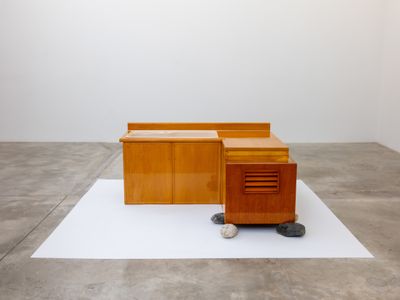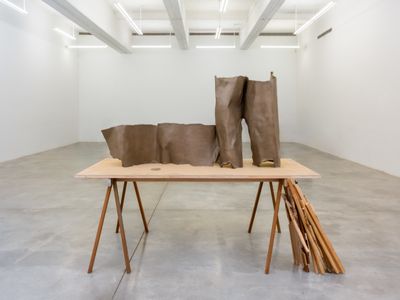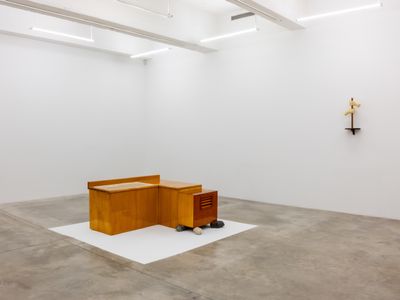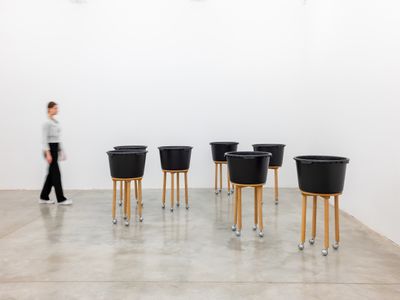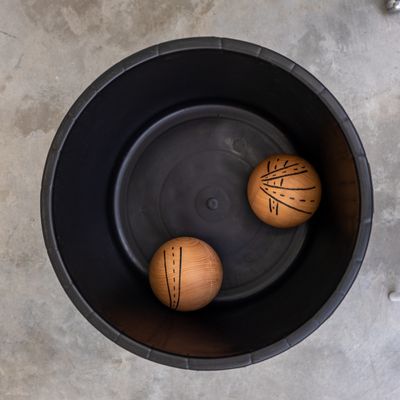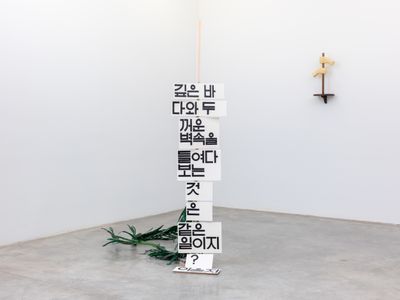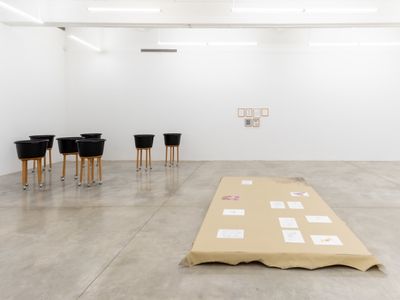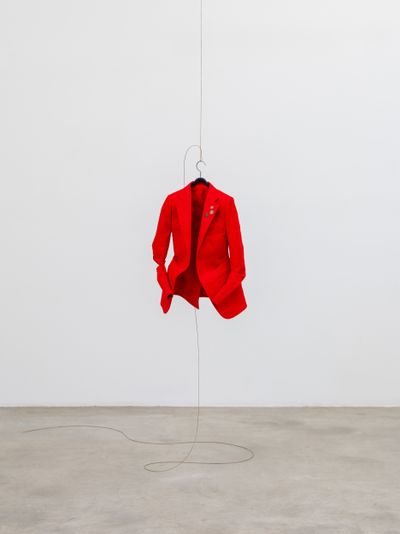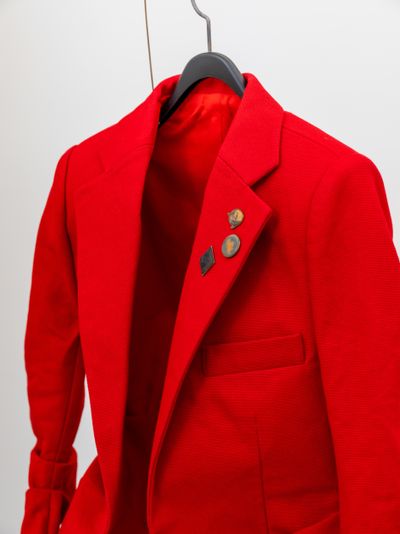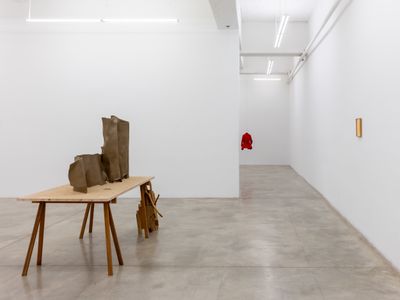Kim Kim Gallery blog
이것은 부산이 아니다: 전술적 실천
MEDIUM: 매체, 예술의 유형, 재료
5월 17일 (금) 오프닝 오후 4시
5월 19일 (일) 오후 3시 / 오후 3시 30분 / 오후 4시 30분
5월 26일 (일 ) 오후 3시 / 오후 3시 30분 / 오후 4시 30분
6월 2일 (일) 오후 3시 / 오후 3시 30분 / 오후 4시 30분
매체는 예술의 유형(예: 퍼포먼 스, 회화, 조각, 판화)뿐만 아니라 예술 작품이 만들어지는 재료 모두를 지칭한다.
WC The 장하지 않는다. The 않고 생활에서 녹아져 나오는 수행적 과정이 있는 작업들이다.
디나 이주영 이이난 주재환 파리즈 허윤희
Wirloof Blanche Endive Witty
Chung Seoyoung on the Density of Objects
https://ocula.com/magazine/conversations/chung-seoyoung/
In Conversation with Lauren Cornell
New York, 18 April 2024
Chung Seoyoung. Courtesy the artist and Tina Kim Gallery. Photo: Charles Roussel.
In the mid-1990s, Chung Seoyoung gained recognition in Korea for her use of unorthodox materials, employing commonplace and industrial objects to create her sculptural installations.
Chung stresses minimal intervention, altering objects into new forms that produce different relations with one another. Road (1993), for example, consists of seven plastic buckets on wheeled stools. Each bucket holds wooden balls with intersecting roads drawn on them—a makeshift map that changes with the tiniest movement.
For Sink (2011), a functional sink was removed from a defunct model house and reconfigured without its faucet and handles, presented at a lower-than-average height, with one end propped up with stones. The incongruity of combining natural and artificial materials is paralleled in the bronze-cast pants in Trousers Peel (2024), unravelled on a plywood table with one heavily loaded leg.
The lack of concrete meaning in Chung's sculptures resounds in the title of her latest solo exhibition at Tina Kim Gallery in New York. With no Head nor Tail (21 March–20 April 2024) invokes a similar absence of direction: as the artist explains in this conversation, despite the number of references she can bring into the artwork, 'in the end, I don't think that really matters.'
With no Head nor Tail follows from What I Saw Today—Chung's 2022 retrospective exhibition at Seoul Museum of Art, which also featured her key works from the early 1990s to the present. In both exhibitions, time is displaced twice: once when Chung created them, decontextualising their original materials, and within the exhibition space, where they are presented in a non-chronological order.
In this transcribed conversation with Lauren Cornell, Chief Curator at Hessel Museum of Art at CCS Bard in New York, Chung discusses the density of objects and the nuanced role of language in her practice, which she treats as a medium to create different realities.
LCI would like to discuss the work Sink (2011). It is the very first piece that you encounter when you come into the gallery; it's a sculpture in the centre of the front room. It is a significant work of yours that was included in What I Saw Today, your retrospective exhibition at the Seoul Museum of Art (SeMA) in 2022, and was first shown in an exhibition called Apple vs. Banana in 2011, which was held in a defunct model home in Seoul. Can you discuss how Sink came to be?
CSYWhen I first started came across the model house, I conceived it as one big piece of art. It was constructed in an effort to build apartments in Korea, which were a sign of wealth in the 1990s, particularly in Apgujeong District in Gangnam, south of the Han River of Seoul. It hadn't been used for 10 years or so, and I opened its doors for the first time since then for that exhibition.
And when I opened the model house, I realised that there were a lot of these objects inside that were supposed to be functional for human existence. But time had stopped, everything had stopped when I opened the doors of this house. That meant I could do anything with it. So I thought that I could create something based on what was going on in that particular apartment, both in terms of its environmental conditions and the objects within it.
I took off the sink from the wall and reorganised the objects that were surrounding it to support it. And when I began the process, I realised that it would read as a sink, but at the same time that it would not be a real sink per se, because I'd taken it out of the context of the model house.
Really, the question was: 'how much can I change the sink?' And for me, what was important was to transform it in the most exact way with minimal intervention. I could have transformed it in a quite drastic way, and it could address, for instance, the history of the sink and how it came to be situated within the domestic environment. But for me, the focal point was to intervene into the object as minimally as possible, and then bring it to be viewed in a different context. I wanted to discover the characteristics of the sink that were implied within the object, but change one or two of its characteristics and bring it to a completely different point. And that's really what I consider to be a central point in my practice.
Sink is an interesting object because it arrived after a very long process of what I refer to as 'negotiation'. There was also the additional element of distance where I brought it to New York for this exhibition after such a long time. The amount of distance and time that the sink had travelled is something that I cannot really explain myself. In a way, different people can come up with various meanings behind such a gap in time and distance so that they understand the course of its existence.
The title of the exhibition, Apple vs. Banana, encapsulates the moment before and after my career. 'Apple versus Banana' could have been 'Apple and Banana' or 'Apple comma Banana', but the moment I inserted 'versus' in that title, apple and banana started having a different relationship. And that kind of conflictual relationship that I'd formed between the apple and the banana interested me, as it created an active state in which I could mobilise a lot of different possibilities.
LCYour exhibition at Tina Kim Gallery, like your retrospective What I Saw Today, wasn't laid out chronologically, which to me is significant because it blurs the time periods and eras in which the works were made. In a way, they feel 'out of time.' And yet, because the materials have these specific references, they are still charged with history and place.
This non-chronological installation dramatises a way that your work has been described, which is that it speaks to collective memory and in particular, the collective memory of Korea. But this memory also isn't fixed, as it's always evolving and because everyone comes to it differently. Can you speak about the notion of collective memory through Road (1993)?
CSYLet me start with the title of the exhibition. In 'With no Head nor Tail', it is assumed that the tail was there, but it's not there anymore. So even from the starting point of this title, I am trying to make myself different or make myself into an entity that I completely do not know. As always, the title of an exhibition or a work is a condensation of many different ideas of working as an artist. As an artist, you can bring in a lot of references to prove why a particular work is important. But then, in the end, I don't think that really matters. Everyone may think that something is very important, but maybe none of what everyone thinks is very important. This idea of leaving somewhere empty-handed or being empty-handed perhaps touches at the most fundamental aspects of art, as you don't make art for any guarantee of success.
I'm interested in that idea of 'no head, nor tail' because without a head, you're dead. The idea of no head is assuming this state of urgency. And thinking about the state of urgency was important because when I was putting together the show, it wasn't necessarily a retrospective per se, but it was a show that tries to condense a rather long period within my practice. And somehow in the title, I'm worrying about this tail that never even existed.
Let's return to Road. The idea of Road doesn't come from the idea of memory that is very broad, or from the kind of memory that has a very specific reference to art or literature. For me, what's interesting is this idea that we all share a certain memory and that individual objects can have individual memories. The fact that there's a shared memory—or, as you called it 'collective' memory—is very interesting. For me, this question started to form when I came across a journal article of sorts about the human brain. The main idea of the article was that when you see something three-dimensional, there is a process of inputting that information into the brain that treats the object as if it were a flat, two-dimensional thing. Then the brain goes through the process of transforming this information into a three-dimensional object. That was quite interesting to me.
And this was a piece of information that resonated with something else that I had thought before: when I was driving on the highway for a long period of time, like six, seven hours, I realised that actually what I was seeing was just a very simple view in front of me, this road with a yellow line in the middle. Even if I travelled through this immeasurable distance that required me to drive for six, seven hours, what I, in the end, had was this two-dimensional image of this road, this line in front.
While I was thinking about this very broad range of time and space, I came across this idea of the container as a signifier of collective memory. When I made Road in Germany in 1993, they were using this plastic container to mix cement, so I was thinking about how that object in and of itself could be a container of collective memory of that particular moment in time. And I wanted it to portray it in a very light-hearted and humorous way, because the container and the object inside can roll around with the wheels connected below. For me, this is an indication of how unstable the object, let alone the overall installation, can be, and how we can think about collective memory in a similarly 'unstable' fashion.
LCThe open-ended aspects of your work and its humour make me think of how so many pieces in this exhibition deal with language. You have quite a few glazed ceramics on the platform in the second room. Some of them have figures like Who? (2023) or Bear? (2023) and some of them use phrases and questions that are nonsensical, provocative, open—they stretch your mind. One of them in Korean says, 'in the deep past we wandered without a home and didn't work so much.' And one of them in English says, 'nature has no goals right?' How does language operate in your work as a kind of material?
CSYIt is somewhat paradoxical for me to think about language. Language is interesting to me, because it is a tool that everyone uses, just like the everyday objects that I use in my sculptures. Changing something small about a particular object transforms it into a completely different entity, and the fact that I can change language and its location ever so slightly is a very good indication of how I can use it as a tool—just like how I brought the sink and changed its minute specificities to bring it into a different reality. As such, I am using or transforming languages with the same sentiment or attitude that I have towards sculptures to bring them into a new reality. I'm curious about how language can make us understand or doubt or even surprised. And that's why, as I said earlier, how I use language may seem paradoxical, because it is a way for me to face reality in a completely different way.
Let me share a realisation that I had this morning, which was about why I work in the way I do. There was a show that I did in 1998 with a few friends, which I hadn't thought of for a long time, that just came to my mind. It was titled Feed+Back. What interested me and my friends was this notion of the back. The back is a part of our body, completely attached to the frontal half, but you only can see it through a mediating object; you can never see it yourself. And the fact that I'm only able to see through a mediated form creates a rather mysterious conflictual relationship between what we can understand and perceive immediately and what we cannot. And I think that's how I started using 'versus' as a way to think about relationships. That's also a point at which I started thinking about a way of finding reality that I mentioned earlier.
LCYou studied sculpture in Seoul National University in the 1980s. Then you moved to Stuttgart and you were there from 1989 to 1996. You returned to Korea in 1996, which, as we know, was the time that the country was undergoing a financial crisis that led to a major national reckoning and precipitated social change. This was a tumultuous time to return. How did studying abroad and returning at that moment influence your practice, which also rose to such prominence at that time?
CSYWhen I look back at that moment, I think, 'something invaded my retina.' When I returned to Korea at the end of the 90s, it felt like everything in Korea had just literally invaded my senses.
Because it was obviously a society that was very much in flux, there were a lot of forces that tried to control what it was going through. But there were a lot of things that were falling apart as well—the system was quite literally out of control. These things came across very vividly. The scenes in which certain objects were getting out or falling out of the system were particularly interesting to me.
What was important was to not analyse nor research the phenomena of this society or try to understand in logical terms how this society came to be, but to help others see directly what I was seeing. And I think this is a point that also harkens back to the title of the SeMA retrospective, What I Saw Today. The central question for me was about going through minimal intervention and allowing people to see the problem itself—finding the exact point at which I allowed others to see what I was seeing.
Much of my thinking revolves around my intuition. Intuition is not something that can be acquired very suddenly or out of nowhere. It really requires layers of accumulated thinking.
LCFollowing up on that point of intuition, Sung Hwan Kim, in an interview with you included in the SeMA catalogue, asked you about your thoughts on what he called the 'schizophrenic state' of Korean society and art in the 1990s, and on how Korean contemporary art was historicised from a global perspective. I run a graduate programme and we think a lot about how periods are historicised, and how we can examine and unravel those processes. I thought your answer to Sung Hwan was really revealing, and I'm going to excerpt it:
'Isn't the so-called schizophrenic state of South Korean society a cycle of this: life is bound and dragged around by events only to eventually disappear into oblivion, and a piece of that life reappears in an unexpected form at an unexpected place, either assaulting someone or left not even noticed?'
I pulled out that quote because I think that your sculpture could also be described in those terms as 'a piece of that life reappearing in an unexpected form.' Your sculptures aren't making a direct address to current events, but they are encoding specific times and lives in them.
I thought we could bring this up to the present and talk about how this operates in one of the new works that's in this show. Could you speak a bit about Red (2024) and what this 'encodes'?
CSYTo think about this recent work, it's important for me to think about the SeMA retrospective and the problems and questions I was dealing with at that moment. At the time, I was thinking a lot about everyday objects and sculptures that I had worked with for a long time, but it was quite difficult for me to think about them in the same way. I concluded that this was because objects and sculptures have a certain density, and I felt that density was really thinning out and getting lost.
I was preparing for the SeMA retrospective during the summer as it opened in September. I had seen all these cicadas around Korea as they become active in the summer and saw that they had shed and just left their shells on the trees. I was coming to recognise that the way in which the density of objects thinned out was actually very similar to how the cicadas shed and left their shells. That was a moment that really hit me in terms of how I was thinking about the status of objects today.
So I wanted to approach this question as a sculptor. The answer was that I should 'make' objects rather than 'rely' on them. In other words, I had to 'make' something, rather than 'change' pre-existing objects. And this is why I made Red, which is on view here. It is an object that I made, but it is not a real jacket per se. It's just like when you have bad eyesight and your images don't line up properly. It's a jacket that is a bit 'off', to put it casually.
There's a direct motivation behind this work. It can be dated back to 2017, when I came to New York for my solo exhibition titled Ability vs. Invisibility here at Tina Kim Gallery. I went to see the Charlotte Brontë show at the Morgan Library, and there were a lot of postcards and drawings that she made, as well as various items of clothing. And this moment of seeing her clothes right in front of me was quite interesting, because they were not shown in a vitrine. They weren't protected in any way and were quite literally sitting in front of me. And this moment was quite confusing, because I was seeing a life-size body of a human being that is so tiny and humble, which I'd never encountered before.
I felt that when I saw that clothing, there was a bit of a space between the dress and myself that wasn't quite estimable or definable. I think this is similar to the ways in which we think about the sensations or experiences that have passed. I held that experience in me when I was looking at Charlotte Brontë's dress, and then when I came back to the studio later on, I decided to focus on that moment to address the questions of the present.
모든 섬은 산이다 Every Island is a Mountain; 베니스비엔날레 한국관 30주년 특별전시, 1995 – 2024
〈Raving〉(2024)은 성낙영이 직접 작곡한 음악의 믹스, 온라인 문화와 지루한 현실 세계 간의 연결을 시도하며 연결과 고립이라는 모순된 키워드를 표현하는 포스터 시리즈로 이루어져 있다. 다양한 서브컬처와 소셜 미디어의 영향을 받은 〈Raving〉은 마치 작업을 준비하는 단계에서 무작위적으로 만드는 이미지의 모음인 무드보드처럼 느껴지기도 한다. 성낙영은 과잉된 요소들이 순간순간 스쳐지나가는 인터넷의 흐름과 유사한 방식으로 빠르게 작업하는데, 포스터 이미지는 확대된 밈(meme)이나 정체를 알 수 없는 패션 광고 같이 보이기도 한다. 뻔해 보이면서도 지루함을 느끼는 듯한 외로운 인물 주변에는 인터넷에서 다운로드 받은 작은 사진이 독특한 방식으로 결합되며 어두우면서도 무심한 분위기를 자아낸다. 음악은 특유의 유머러스함을 통해 이 공허함을 증폭시키며 공격적이면서도 빠르게 전환된다.
성낙영은 나키온(Nakion)이라는 이름으로 활동하며 서브컬처의 영향을 받은 음악과 미술작품을 제작해왔다. 그의 작품은 매 순간 작가가 겪는 상황과 기분을 가볍지만 동시에 진지하게 고찰하고 반영하며, 감상하는 이로 하여금 일상적인 디지털 세계와 물리적인 현실 세계 안에서 경험하는 정신적인 소란스러움과 혼란에 진입하게끔 한다.
성낙희
2005년 제51회 참여 작가
아크릴 회화와 벽화를 주 매체로 활용하는 성낙희는 즉흥적이고 직관적인 선과 형태, 색의 선택을 통해 자유로움을 견지하는 동시에 조직적이고 구성적인 추상화 작업을 해왔다. 최근에는 한 화면 안에서 중심적인 색조의 활용과 그 변주, 그라데이션과 보색을 활용하여 색면 간의 경계가 또렷이 드러나면서도 유동적인 느낌을 담은 구축적인 회화를 제작하고 있다.
벽화의 형태로 선보이는 〈Cozy Cardio〉(2023)는 굽이치는 유동적인 선과 면, 두드러지는 노란색과 보라색 등 서로 대비를 이루지만 반복적인 색의 활용을 통해 성낙희 작품에서 고유하게 드러나는 음악적인 리듬감을 담아낸다. 작품의 제목인 ‘Cozy Cardio’는 틱톡 등의 소셜네트워크서비스에서 유행하는 용어로, 편안한 상태에 머물면서 하는 유산소 운동을 의미한다. 하지만 작품의 제목은 이 용어가 일반적으로 가리키는 상황과 관계가 있기보다는 작가가 작업을 하면서 가진 느낌을 적절히 전달할 수 있는 표현을 직관적으로 선택함으로써 붙여졌다. 추상적인 형상들과 과슈, 색연필, 오일파스텔 등 다양한 재료를 그라데이션, 뿌리기 등을 통해 종이의 표면과 맞닿게 하면서 나타나는 다양하고 독특한 질감은 언어로 표현되지 않는 내면의 율동감을 풍부히 드러낸다.
정서영
2003년 제50회 참여 작가
정서영의 작품은 작가의 내면과 사물이 일시적으로 공명하는 순간을 포착한다. 주로 일상적인 사물이나 재료를 사용하지만, 작품에서 중심이 되는 것은 재료의 재질과 외관이 부여하는 형태 자체뿐만 아니라 작가가 사물과 총체적, 직관적으로 관계 맺는 방식이다. 따라서 정서영의 작품은 상징적인 의미작용을 비껴가는 존재로서 관람객에게 말을 걸어 온다.
〈증거〉(2014)는 사람의 손이 두 자루의 펜과 구겨진 종이 조각, 나뭇잎과 가지를 한 번에 움켜쥐고 있는 모습을 전면적으로 포착한 사진이다. 일상적이거나 인공적인 사물, 식물 등의 자연물, 인간의 신체와 같이 서로 낯선 사물들이 하나의 견고한 덩어리가 되었지만 동시에 그것들 간에 길항하고 있는 힘이 정지된 장면 속에서도 보인다. 이 특수한 모습의 근거나 배경을 이루는 외부적인 서사나 이야기에 대한 추측은 가능할 수 있으나, 이 장면은 논리적이고 합리적인 설명을 요청하지 않는다. 오히려 이 모습뿐만 아니라 세상 속에 뒤엉켜 있는 모든 사물들의 모습 그 자체가 실은 그 자신의 존재에 대한 자족적인 증거임을 암시한다.
김범, 〈켄타우루스와 미노타우루스>, 2020, 단채널 비디오, 57초, 반복재생
김범
2015년 제51회 참여 작가
김범은 회화, 드로잉, 조각, 비디오, 아티스트 북에 이르는 다양한 작업을 통해, 인간의 지각이 근본적으로 의심되는 세계를 다루어 왔다. 관습을 뒤집는 진지한 유머와 부조리한 제안이 특징인 그의 시각언어는 실재하는 대상에 대한 인식과 지식의 체계가 얼마나 허술하고 관념적인지를 해학적으로 드러내왔다.
김범의 작업에서 인간이 도구 혹은 수단의 대상과 결합하는 상황은 큰 관심사로 등장해왔다. 영상 작업 〈켄타우루스와 미노타우루스(원형 버전)〉(2020)에는 로데오 경기에서 야생성을 정복하고자 하는 인간과 이에 저항하는 동물, 그 둘 사이에서 주종 관계를 둘러싼 격렬한 긴장 상태가 담긴다. 하나가 된 상태에서 두 가지 다른 본능과 영혼이 격렬하게 다투는 과정은 고대 신화에서 흔하게 등장해온 반인반수 혹은 괴물의 서사까지 거슬러 올라가, 문명의 전개 속 인간과 도구과 정복자와 피정복자 사이의 변증법적 관계에 대한 성찰을 불러 일으킨다. 4점의 연속사진 작품에서 모든 장면을 이어 제작한 이 영상은 초기 사진기법에 따라 인화된 청사진 프린트(cyanotype)와 반다이크 프린트(vandyke print)의 푸른색과 갈색을 따른다.
베니스비엔날레 한국관 30주년 기념전 《모든 섬은 산이다》를 기획하며
19.4 – 8.9, 2024
Palazzo Malta – Ordine di Malta, Venise
임근혜(예술감독, 아르코미술관 관장)
2024년 베니스비엔날레 기간 중 몰타기사단 수도원에서 열리는《모든 섬은 산이다》는 자르디니 공원의 마지막 국가관인 한국관의 건립 30주년을 한해 앞두고 이를 기념하기 위해 마련된 전시이다.
한국문화예술위원회가 주최하는 이 전시는 역대 참여 작가 중 36명을 한자리에 초대하여 한국미술이 베니스비엔날레를 통해 세계와 접촉하며 국제성과 동시대성을 획득해 온 지난 30년간의 여정을 보여준다.
이를 통해, 한국미술 세계화의 교두보 역할을 해온 베니스비엔날레 한국관이 국가주의와 국제주의의 긴장과 충돌 속에서 분투하며 글로벌 예술 생태계의 다양성과 역동성에 기여하고 있는지 살펴보고자 한다.
전시 제목 ‘모든 섬은 산이다’는 ‘예술을 통한 시간과 공간의 연결’을 상징하며, 섬과 섬이 바다 속 깊은 곳에서 해저 지형과 해양 생태계로 산맥처럼 연결되듯이 고립된 개인의 삶과 예술이 결국 역사와 사회적 맥락에 연결되어 있음을 의미한다. 1993년 베니스비엔날레 독일관 전시를 통해 서구 중심적인 사고가 갈라놓은 유라시아 연속체에 대한 상상과 초연결의 미디어 기술을 통해 분열된 세상을 다시 연결할 수 있다는 메시지를 전한 백남준의 예술이 이번 전시의 개념적 출발점이다.
또한, 최근의 코로나19 팬데믹을 계기로 관심이 높아진 기후위기와 생태에 대한 작가와의 대화, 생명의 순환으로서의 섬에 대한 상징과 은유를 담은 작품, 베니스 지역 해양 생태학자 및 활동가와의 교류 그리고 비위계적이고 탈중심적인 에두아르도 글리상의 ‘군도적 사고’의 개념이 전시 구성의 기본 바탕이 되었다.
《모든 섬은 산이다》는 과거-현재-미래, 개인과 공동체, 지역과 글로벌, 기술과 예술의 경계를 가로지르는 예술적 사유와 실천에 주목하며 1995년 한국관 개관 당시 선보인 작품부터 최근의 신작까지 지난 30년간 생산된 작품 82점을 아우른다.
작가 개인의 예술 작업이 다양한 감각과 서사를 통해 인류의 보편적 가치와 예술적 비전으로 연결되며 섬과 산을 넘나드는 상상적 풍경으로 펼쳐진다
도입부에는 아르코예술기록원이 수집한 한국관 관련 자료를 차세대 작가들의 시각으로 재구성한 도큐멘터리 영상이 과거의 기억을 현재로 소환한다. 전시는 작은 방이 밀집한 수도원의 실내와 고즈넉한 중정 그리고 탁 트인 야외 정원으로 펼쳐지며 베니스의 중세와 한국 동시대의 시간이 서로 겹쳐진다.
그리고, 중간 지대에서 간간이 들려오는 사운드 아트는 군도처럼 존재하는 개별 작품을 바다처럼 둘러싼다.
자르디니 공원에 위치한 한국관의 아웃라인을 본떠 만든 야외 정원의 ‘투명한 파빌리온’은 수도원의 이웃과 비엔날레 방문객에게 열린 휴식의 장소이자 지역에서 활동하는 연구기관 및 예술단체와의 협업으로 진행될 공공프로그램이 진행되는 공유의 장소이다.
한국 미술계에 마지막 국가관을 선물한 백남준을 기념하는 라이브 퍼포먼스 <굿모닝 미스터 백>으로 시작하는 수도원 야외 공간의 다양한 행사는 로컬과 글로벌이 조우하고 교감하며 연결되는 또 하나의 섬이자 산이 될 것이다.
https://www.venicebiennale.kr/
















